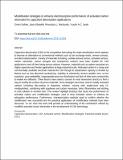| dc.description.abstract | Capacitive deionization (CDI) is the competitive technology for water desalination which appears to become an alternative to conventional methods such as ion exchange resins, reverse osmosis, and electrodeionization. Variety of materials including, carbide-derived carbon, activated carbons, carbon nanotubes, carbon aerogels and mesoporous carbons have been studied for CDI applications most of them being porous carbons. However, materials such as carbon nanotubes are highly expensive and hinder applications at large industrial scale. Activated carbon is a cheap and commercially available electrode material for CDI though its desalination capacity is limited by factors such as low electrical conductivity, inability to selectively remove specific ions, co-ion expulsion, poor wettability, inappropriate pore size distribution and lack of inter-pore connectivity to enable ion diffusion. These factors have raised a concern to most researchers and try to find a way to modify the surface of porous materials. Some strategies have been used to modify activated carbons including dip-coating in dopamine solution, mixing with quaternized poly (4-vinylpyridine), combining with graphenes and carbon nanotubes, direct fluorination and etching in acid solution to mention few. This review highlight factor(s) that cause low performance of activated carbon and modification strategies used to treat activated carbon to enhance its adsorption performance. Furthermore, characterization methods used to confirm whether the modification was successful and the practical application of modification methods have been discussed. To our view this work will provide an understanding of the contribution offered by modified activated carbon electrodes in the development of CDI technology. | en_US |

